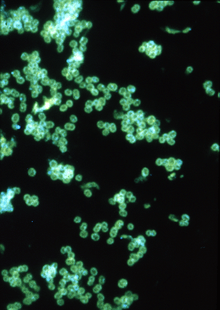Neisseriaceae
The Neisseriaceae are a family[2] of Proteobacteria, within the Neisseriales order. While many organisms in the family are mammalian commensals or part of the normal flora, the genus Neisseria includes two important human pathogens, specifically those responsible for gonorrhea (caused by N. gonorrhoeae) and many cases of meningitis ("meningococcal meningitis", caused by N. meningitidis). As a group, the Neisseriaceae are strictly aerobic and Gram-negative, occur mainly in pairs (diplococci), and typically do not have flagella.
| Neisseriaceae | |
|---|---|
 | |
| Neisseria gonorrhoeae | |
| Scientific classification | |
| Domain: | Bacteria |
| Phylum: | Proteobacteria |
| Class: | Betaproteobacteria |
| Order: | Neisseriales |
| Family: | Neisseriaceae Prévot, 1933 |
| Genera | |
|
Alysiella | |
References
- "Aquaphilus". www.uniprot.org.
- Neisseriaceae at the US National Library of Medicine Medical Subject Headings (MeSH)
- Bacteria of Medical Importance in Todar's Online Textbook of Bacteriology.
- Madigan, Michael; Martinko, John, eds. (2005). Brock Biology of Microorganisms (11th ed.). Prentice Hall. ISBN 0-13-144329-1.
- Ryan KJ; Ray CG, eds. (2004). Sherris Medical Microbiology (4th ed.). McGraw Hill. ISBN 0-8385-8529-9.
This article is issued from Wikipedia. The text is licensed under Creative Commons - Attribution - Sharealike. Additional terms may apply for the media files.